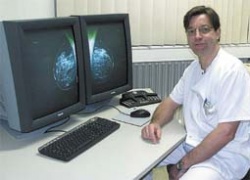Streamlining mammography
All in a day: screening, results and a biopsy booking

Germany - At the Institute of Radiology, University of Wurzburg, patients can undergo mammography, receive results and schedule a biopsy - all on the same day. The Institute, which annually carries out 6,000 mammograms and 350 biopsies, began streamlining its process in 2003, with the installation of a Hologic MultiCare Platinum breast biopsy system. This was chosen for two key reasons, explained Professor Alexander Tschammler, chief physician in the Institute’s breast imaging department: the patient is prone which minimizes movement, and the system facilitates biopsy from above, below or either side, enabling the breast to be reached from any angle. ‘I try to enter the breast from below,’ he added. ‘That way, if there’s a scar, no one will see it.’
Because Germany does not yet allow digital screening - a situation expected to change in 2005 - a few months later the Institute also purchased a conventional Hologic M-IV system to replace the analogue mammography system used there for many years. The professor explained that the change in manufacturers was made because Hologic’s analogue and digital systems are very similar, making it easy for technologists to switch between either, and servicing by just one company proved more attractive - a Hologic support technician was within easy distance, ensuring speed if any changes to the system should be needed.
Last year the university also opted to install a Hologic Selenia full-field digital mammography system, a choice made not only for consistency, but also because, among the full-field products available, in slot scanning technology the scan times were too long, and among the flat-panel equipment on offer, either the field of view was far smaller than Selenia’s 24 x 29 cm FOV, or they did not have a mature system solution worth evaluating, Prof. Tschammler said, adding: ‘The larger field of view is absolutely necessary. A third of our patients don’t fit on an 18 x 24 device.’ In addition to accommodating larger breasts and providing overall great images, the Selenia is also compatible with the hospital’s new PACS system - the entire state-of-the-art imaging/biopsy/image transmission capability will go online early this year.
In terms of digital vs. analogue image quality, contrast in the former is better for visualisation of calcifications and architectural distortion also is more easily visualized, he pointed out, adding that the radiation dose has been reduced by about 10% with the digital system, largely because the improved ability to manipulate digital images has reduced the need for magnification and other additional views. Another advantage is that digital images are produced far more quickly than film images and, if they request it, patients can be given their images on a CD.
However, for now, Germany offers insufficient reimbursement to cover the additional costs involved in a full-field digital screening system. ‘When digital screening is reimbursed, and when the cost of systems comes down, its impact will really begin to be felt,’ the professor predicted. That is, conventional mammography systems will not be needed. ‘Image characteristics of digital mammography and biopsy systems are similar, so it’s easy to go from digital mammography to digital biopsy. The future is digital.’
07.08.2006











